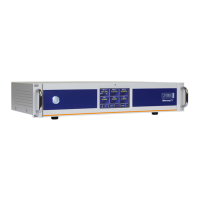MercuryiTC
©2014 Oxford Instruments Omicron NanoScience. All rights reserved.
Page 71
measurement boils off a small quantity of helium. A fast sampling rate is available for use when
the reservoir is being filled.
The maximum probe-length depends on the resistivity of the probe wire:
• For probes up to 1.4 m long, a wire resistivity of 178 ohms/meter is used, with a current of
130 mA.
• For probes up to 2 m long, a wire of resistivity of 61.2 ohms/meter is used, with a current of
250 mA.
5.1.2 Operation of the board with a nitrogen-level probe
The nitrogen-probe consists of two concentric steel-tubes. The tubes act as the plates of a
capacitor, while the annular space between them acts as a dielectric. Liquid-nitrogen has a
relative permittivity of 1.45, so the capacitance of the section of probe under the liquid surface
increases by approximately 45%.
The probe-head includes an oscillator whose frequency depends on the capacitance of the
probe. Thus the oscillator frequency also depends on the level of liquid.
The probe-head requires no adjustment. The working range of the oscillator (5 kHz to 65 kHz)
accommodates probes up to 2 metres long.
5.1.3 Why different methods are used for the two liquids
Liquid helium has a relative permittivity of 1.055, which is similar to the relative permittivity of
helium gas at 4.2 K. The capacitance probe is thus not sensitive to the liquid level when used
with liquid helium.
It is possible to make a liquid-nitrogen probe using a wire made of a high-temperature
superconductor. However, this probe would be much less robust than a capacitive probe.
5.2 Installing the level-meter board
5.2.1 Removing the top cover
1 Turn off electrical power to the iTC.
2 Disconnect all cables from the rear of the iTC and remove the iTC from any instrument rack.
3 Remove the 4 screws holding each rack handle.

